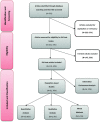What have we learned about communication inequalities during the H1N1 pandemic: a systematic review of the literature
- PMID: 24884634
- PMCID: PMC4048599
- DOI: 10.1186/1471-2458-14-484
What have we learned about communication inequalities during the H1N1 pandemic: a systematic review of the literature
Abstract
Background: During public health emergencies, public officials are busy in developing communication strategies to protect the population from existing or potential threats. However, a population's social and individual determinants (i.e. education, income, race/ethnicity) may lead to inequalities in individual or group-specific exposure to public health communication messages, and in the capacity to access, process, and act upon the information received by specific sub-groups- a concept defined as communication inequalities.The aims of this literature review are to: 1) characterize the scientific literature that examined issues related to communication to the public during the H1N1 pandemic, and 2) summarize the knowledge gained in our understanding of social determinants and their association with communication inequalities in the preparedness and response to an influenza pandemic.
Methods: Articles were searched in eight major communication, social sciences, and health and medical databases of scientific literature and reviewed by two independent reviewers by following the PRISMA guidelines. The selected articles were classified and analyzed in accordance with the Structural Influence Model of Public Health Emergency Preparedness Communications.
Results: A total of 118 empirical studies were included for final review. Among them, 78% were population-based studies and 22% were articles that employed information environment analyses techniques. Consistent results were reported on the association between social determinants of communication inequalities and emergency preparedness outcomes. Trust in public officials and source of information, worry and levels of knowledge about the disease, and routine media exposure as well as information-seeking behaviors, were related to greater likelihood of adoption of recommended infection prevention practices. When addressed in communication interventions, these factors can increase the effectiveness of the response to pandemics.
Conclusions: Consistently across studies, a number of potential predictors of behavioral compliance to preventive recommendations during a pandemic were identified. Our findings show the need to include such evidence found in the development of future communication campaigns to ensure the highest rates of compliance with recommended protection measures and reduce communication inequalities during future emergencies.
Figures
References
-
- U.S. Centers for Disease Control and Prevention (CDC) Public Health Preparedness Capabilities: National Standards for State and Local Planning. 2011. http://www.cdc.gov/phpr/capabilities/Capabilities_March_2011.pdf (accessed August 2012)
-
- Blendon RJ, Benson JM, Desroches CM, Weldon KJ. Using opinion surveys to track the public's response to a bioterrorist attack. J Health Commun. 2003;8(Suppl 1):83–92. discussion 148–151. - PubMed
-
- Viswanath K. In: Examining the Health Disparities Research Plan of the National Institutes of Health: Unfinished Business. Thomson GE, Mitchell F, Williams MB, editor. Washington, D.C: Institute of Medicine; 2006. Public communications and its role in reducing and eliminating health disparities; pp. 215–253.
Publication types
MeSH terms
Grants and funding
LinkOut - more resources
Full Text Sources
Other Literature Sources
Medical




